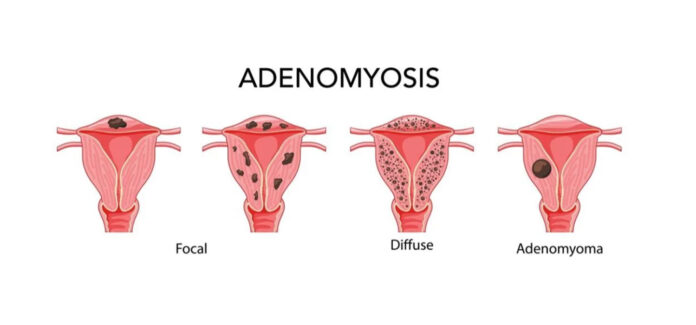The condition known as adenomyosis (pronounced “ad-uh-no-my-O-sis”) is the result of endometrial tissue, which normally lines the uterus, growing into the uterine muscle wall. During each menstrual cycle, the displaced tissue continues to behave normally, thickening, degrading, and bleeding. Painful, heavy periods and an enlarged uterus may ensue.
Although the exact cause of adenomyosis is unknown, the condition typically goes away after menopause. Hormonal therapies may be helpful for women whose adenomyosis is causing them great discomfort. Adenomyosis is cured by hysterectomy, or removal of the uterus.
Symptoms
Adenomyosis can occasionally only cause minor discomfort or no symptoms at all. But adenomyosis can result in:
1.prolonged or intense menstrual bleeding
2.severe pelvic pain during menstruation that feels like a knife (dysmenorrhea)
3.persistent pelvic discomfort
4.painful sexual relations (dyspareunia)
Your uterus may enlarge. You might feel pressure or discomfort in your lower abdomen, even if you’re not sure if your uterus is larger.
Causes
Growth of invasive tissue. According to some specialists, the muscle that makes up the uterine walls is invaded by endometrial cells from the lining of the uterus. Incisions made in the uterus during procedures like caesarean sections (C-sections) may encourage the direct infiltration of endometrial cells into the uterine wall.
Origins in development. According to some experts, when the uterus first forms in the fetus, endometrial tissue is deposited in the uterine muscle.
Inflammation of the uterus caused by childbirth. There is another theory that links adenomyosis to childbirth. The normal boundary between the cells lining the uterus may break during the postpartum period due to inflammation of the uterine lining.
Origins of stem cells. Adenomyosis may result from bone marrow stem cells invading the uterine muscle, according to a recent theory.
Adenomyosis grows in response to the body’s circulating oestrogen, regardless of how it develops.
Treatment
Options for adenomyosis treatment consist of:
Medications that reduce inflammation. To manage the pain, your doctor may prescribe anti-inflammatory drugs like ibuprofen (Advil, Motrin IB, and other brands). You can lessen menstrual blood flow and help relieve pain by starting an anti-inflammatory medication one to two days before your period starts and continuing to take it during your period.
Hormone-related drugs. Hormone-containing patches, vaginal rings, or combined estrogen-progestin birth control pills may reduce heavy bleeding and pain related to adenomyosis. Amenorrhoea, or the lack of menstruation, is a common side effect of progestin-only contraception, such as an intrauterine device or continuous-use birth control pills, which may offer some relief.

































